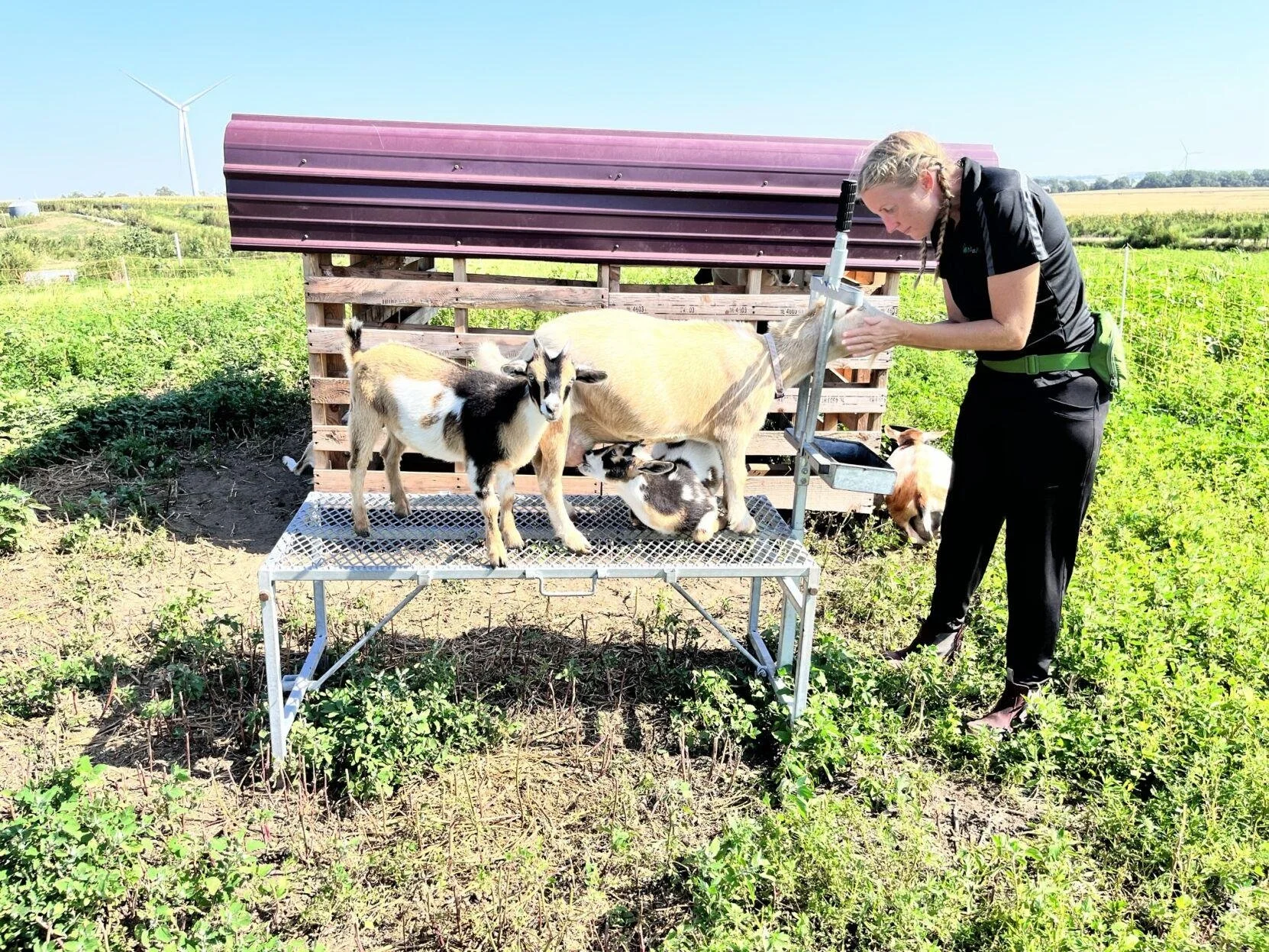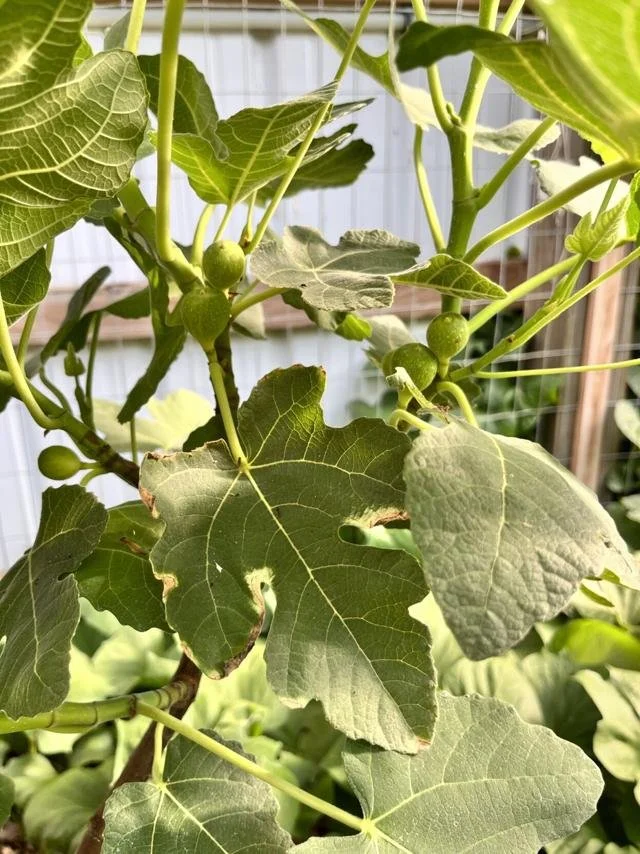USA: NEBRASKA - Locally Grown, All Year Round: Midplains Produce
September 15, 2023
Midplains Produce near Elgin, Neb., is run primarily by Tiffany Hemenway, left, Rachelle Green and Rachel Uhrenholdt.
In an agricultural-heavy region where acres of cornfields stretch as far as the eye can see, it may be hard to believe that cattle are closer to their food source than humans. In reality, Nebraskans are at the end of the food supply chain.
“Southwest Antelope County is a known food desert. We are trying to fill that gap in the community,” said Rachel Uhrenholdt.
Her business, Midplains Produce, provides a local food source 365 days a year. Located on a farm between Petersburg and Elgin, Nebraska, Midplains Produce is able to grow fruits, vegetables and herbs year-round in a geothermal greenhouse and a Freight Farm hydroponic system. During the summer, other vegetables are also propagated outdoors using Uhrenholdt’s distinct deep-mulch method.
Uhrenholdt has integrated her poultry flock and Nigerian dwarf goat herd into her business plan, selling eggs and goat milk soap. The animals in turn benefit her market garden by eating garden scraps and providing used bedding to be composted for the garden.
Rachel Uhrenholdt raises Nigerian dwarf goats, composting the used bedding to mulch her market garden for Midplains Produce. She also sells goat milk soap. Submitted photo
“There is minimal waste—it’s all getting used,” said Tiffany Hemenway, bookkeeper and client contact for the Midplains enterprise.
Midplains Produce is one of three businesses owned by the Uhrenholdt family. Rachel Uhrenholdt’s parents, Richard and Donna Uhrenholdt, own and operate Midplains Ag, a full-service precision agriculture consultation and risk management group. Holdt Farms is the family’s farming operation.
The Uhrenholdt family has farmed in Antelope County for over 115 years. Uhrenholdt’s grandparents lived in the farmhouse where Uhrenholdt and her two daughters now reside. This is the same property where she now operates Midplains Produce.
Pesticides are not used at Midplains Produce, and everything grown in the greenhouse and outside is grown using organic practices. The hydroponic system uses nutrients to feed the plants so is not technically organic.
For Uhrenholdt, having clean food to eat is a matter of necessity. She had lived in California eight years for health reasons but returned to Nebraska in 2020. After her grandmother passed away, the family needed help caring for her disabled uncle. Moreover, COVID was ramping up.
“That’s when everything locked down and I was put on unpaid leave for work,” Uhrenholdt said. She made a quick decision and moved back to Nebraska.
Coming from Ventura County north of Los Angeles, Uhrenholdt missed having fresh food at her fingertips, such as kale, artichokes, avocados and other foods some Midwesterners would consider a treat.
“I got used to really good quality produce,” said Uhrenholdt.
Inside of a storage unit at Midplains Produce, heads of lettuce grow from foam channels in the hydroponic system. Lettuce is part of the Farm to School initiative Midplains Produce is trying this year. Submitted photo
To keep a fresh supply of clean food year-round, the Uhrenholdt’s purchased a Greenhouse in the Snow kit. Construction began in October 2020. The exterior of the geothermal greenhouse measures 156 feet long by 17 feet wide, with the grow room being 120-foot long. They opted to add 6-foot overhangs on both ends of the greenhouse so that the windows can be left open constantly during the warm months, Uhrenholdt said.
Uhrenholdt quickly filled the grow room with a wide variety of herbs: turmeric, ginger, mint, rosemary, thyme, basil, sage and oregano. In the center section of the greenhouse, which is dug deep into the ground about 4 feet, she planted taller plants and even trees. Most of these trees were in pots until last year, so the little saplings are still taking root and starting to grow upward. She is anticipating a good harvest in the future of lemons, limes, kumquats, mandarin oranges, blood oranges, navel oranges, grapefruit, figs and pomegranate.
The banana trees were planted in April 2021 and are flourishing in the hot greenhouse environment. Uhrenholdt has to regularly prune them shorter. She almost got a banana harvest last winter.
“They bloomed, but unfortunately I didn’t have my supplemental heat figured out when that cold snap hit in December,” Uhrenholdt admitted. “They got hit by frost, so the bananas rotted instead of ripened.”
Cassava is another exotic species growing in the geothermal greenhouse. Uhrenholdt will dig up the root and boil out the starch to harvest tapioca from this plant.
She also grows holy basil and ashwagandha, both adaptogenic medicines to help the body with stress.
Lining both sides of the geothermal greenhouse are essentially raised beds, although they are built level with the outside ground. Here, Uhrenholdt grows an array of hot and sweet peppers.
And while everyone else’s gardens in Nebraska are nearing summer’s end, cucumber and tomato plants are still stretching their tendrils up the trellises and twine Uhrenholdt has installed inside the geothermal greenhouse.
“They’ll be producing when everyone else’s are done,” she said.
Along the outer berm of the greenhouse, Uhrenholdt has a long line of tomato plants, as well as okra, squash, horseradish, rhubarb, strawberries, raspberries, pollinator plants and more. A separate area is dedicated to her potato patch, dent corn field and study plot for the Nebraska Urban Soil Health Initiative through the University of Nebraska-Lincoln. She also grows livestock forage for her goats and chickens, including Mangel beets, comfrey and sunflowers.
All of the plants are embedded in a thick layer of mulch made from leaves, used animal bedding and garden scraps. Uhrenholdt recently built three static aerated composting bins that circulate air through a pipe, so no manual turning of the compost is required.
Warm-weather crops, such as this fig tree, thrive in the warm geothermal greenhouse at Midplains Produce.
Submitted photo
For compost that includes used bedding to be considered food grade, the pathogens must be killed. Uhrenholdt has chosen a technique that maintains a temperature of at least 131 degrees for three consecutive days without being turned. After the composting process is complete, she can then apply it as deep mulch around her garden or use it to feed her worm bin.
The Freight Farm greenhouse is about the only place where the compost is not utilized. Since seeds are started in moss plugs, there is no soil whatsoever in the process.
A hydroponic system, the Freight Farm is contained within a storage unit sitting not far from the geothermal greenhouse. The Uhrenholdt’s purchased their Freight Farm from a company in Boston. The first planting was October of last year.
Rachelle Green of Erickson, Nebraska is responsible for the daily maintenance of the Freight Farm at Midplains Produce. She explained how the water and nutrient tanks automatically dose the lettuce growing within the Freight Farm.
“It basically runs itself. All I do is maintenance, clean and move plants around,” said Green.
The system can be controlled through a computer or cell phone. Humidity within the storage unit is maintained at 70 and the temperature stays at 65 degrees.
A series of panels with foam channels allow plants to grow vertically within the unit. There are 88 panels total, each with the capacity for 30 lettuce plants.
Every 20 minutes, water runs for seven-minute intervals through the channels. LED lights shining on both sides of the panels mimic “night” and “day” light waves.
Green follows a “cut and come again” harvesting method. She can typically get three cuttings off of one plant over a 6-week period. On average, she collects 50 to 70 ounces from five panels.
“My best harvest was an ounce and a half per plant,” Green said proudly.
Midplains Produce sells their lettuce and other products at local farmers markets. They have found that lettuce sells better by the ounce than if pre-bagged. Green was happy to report that demand has “gone up amazingly in the last month.”
They are also excited to be collaborating with Boone Central Schools for Farm to School.
“One of our big goals is to work with local schools and sell them our produce because the kids need healthy, local food,” Uhrenholdt said.
Midplains Produce received its first lettuce order from Boone Central Schools this August. Participating in this grant-funded program is a first for both; Uhrenholdt said they are all learning together.
Green will harvest about 2 1/2 pounds of lettuce on Friday and deliver it to the school 20 miles away later that day if possible. It doesn’t get much more fresh or local than that.
“I love that you can help out locally and help the kids. That’s huge,” Green said.
People can purchase from Midplains Produce online. In addition to different produce, they offer honey, farm fresh eggs, goat milk soap and salve. Visit their website at www.midplainsproduce.com and click on the “shop” button.
“Everything keeps changing as we get more stuff. It’s never the same but we have our regulars, like lettuce,” Hemenway said.
Being able to grow food for your family can be a feat. Feeding your community is remarkable. But having the capability to provide a freshly-grown, local food source—all year long—is simply amazing. Midplains Produce is closing the gap in the food supply chain right here in Nebraska.
Reporter Kristen Sindelar has loved agriculture her entire life, coming from a diversified farm with three generations working side-by-side in northeastern Nebraska.
Reach her at Kristen.Sindelar@midwestmessenger.com.





